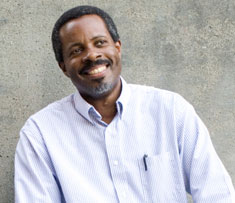Do Helping Hands Make for Better Engineers?
A new study seeks to discover if service learning leads to better engineering education—and more women in the field
By Marjorie Howard

“We think service learning may engender a stronger engineering ethic, making you more motivated and confident,” says Chris Swan. Photo: Melody Ko
Chris Swan and a group of his colleagues are studying something they have long observed anecdotally: women are more interested in engineering when their work involves a combination of academics and community service.
“Some people believe service learning distracts from hard-core engineering skills that we should be providing,” says Swan, an associate professor in the department of civil and environmental engineering. “I agree that we need to teach those skills, but we want to see if you get a benefit from doing a project for, say, a village in Guatemala. We think it may engender a stronger engineering ethic, making you more motivated and confident.”
With a three-year, $500,000 grant from the National Science Foundation, Swan is leading a team of students and faculty that is studying whether service learning attracts more women to engineering and whether it can enhance engineering education overall. Joining Swan are Linda Jarvin, a research associate professor and director of the Center for Enhancement in Learning and Teaching; Chris Rogers, a professor of mechanical engineering; Adam Carberry, a graduate student in the education department; and Gay Lemons, a postdoctoral associate in engineering. Faculty and students from Purdue University are also participating in the study.
A better understanding of how service learning works can be useful not only in a university setting but also in the professional world, Swan says. He notes that 40 percent of the members of Engineers Without Borders, a national student organization that works on community projects around the world, are women. Yet in the professional world, only about 5 percent of engineers are women. “There is a big attrition rate from getting a degree in engineering to practicing engineering,” he says.
In one part of the study, engineering students will be asked to design a jar opener for a one-armed person. The research team wants to find out if students will use standard engineering design processes for the task, or if designing the tool for a particular person motivates them differently in their work.
In this first year of the study, students also are being surveyed about their views of engineering, how they see themselves as engineers and how they solve engineering problems. The goal is to determine if students who participate in service learning are different from students who engage in independent research but not in service learning.
Swan points out that Tufts already has a strong service-learning component and a higher than usual number of women enrolled in the School of Engineering. Women make up approximately 32 percent of the student body at the school, compared to 15 to 20 percent at the country’s other engineering schools.
Marjorie Howard can be reached at marjorie.howard@tufts.edu.

